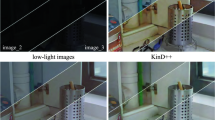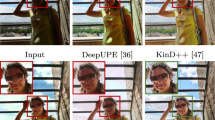Abstract
As the dynamic range of displays keeps increasing, there is a need for reverse tone mapping methods, which aim at expanding the dynamic range of legacy low dynamic range images for viewing on higher dynamic range displays. While a number of strategies have been proposed, most of them are designed for well-exposed input images and are not optimal when dealing with ill-exposed (under- or over-exposed) content. Further, this type of content is more prone to artifacts which may arise when using local methods. In this work, we build on an existing, automatic, global reverse tone mapping operator based on a gamma expansion. We improve this method by providing a new way for automatic parameter calculation from the image statistics. We show that this method yields better results across the whole range of exposures.









Similar content being viewed by others
Notes
From this point on, we will use the symbol γ to refer to the parameter of the expansion curve, and the word gamma when referring to the expansion method or the type of curve.
References
Adams A (1983) The print. The Ansel Adams photography series. Little, Brown and Company
Akyuz AO, Reinhard E (2006) Color appearance in high dynamic range imaging. J Electron Imaging 15:3
Aydin TO, Mantiuk R, Myszkowski K, Seidel HP (2008) Dynamic range independent image quality assessment. ACM Trans Graph 27(3):69
Banterle F, Artusi A, Aydin T, Didyk P, Eisemann E, Gutierrez D, Mantiuk R, Myszkowski K (2011) Multidimensional image retargeting. In: ACM Siggraph ASIA 2011 courses (December 2011). ACM Siggraph ASIA, ACM
Banterle F, Artusi A, Debattista K, Chalmers A (2011) Advanced high dynamic range imaging: theory and practice. A.K Peters, Ltd.
Banterle F, Ledda P, Debattista K, Chalmers A (2006) Inverse tone mapping. In: GRAPHITE ’06. ACM, New York pp 349–356
Banterle F, Ledda P, Debattista K, Chalmers A (2008) Expanding low dynamic range videos for high dynamic range applications. In: Proceedings of the spring conference on computer graphics. ACM, New York
Banterle F, Ledda P, Debattista K, Chalmers A, Bloj MA (2007) Framework for inverse tone mapping. Vis Comput 23(7):467–478
Cadík M, Wimmer M, Neumann L, Artusi A (2008) Evaluation of hdr tone mapping methods using essential perceptual attributes. Comput Graph 32:330–349
Didyk P, Mantiuk R, Hein M, Seidel H (2008) Enhancement of bright video features for HDR displays. Computer Graphics Forum 27(4):1265–1274
Dumouchel W, O’Brien F (1991) Integrating a robust option into a multiple regression computing environment. Springer-Verlag, New York, pp 41–48
Eilertsen G, Wanat R, Mantiuk R, Unger J (2013) Evaluation of tone mapping operators for hdr-video. In: Computer graphics forum (Proc. of pacific graphics 2013), p 32
Fairchild MD The HDR photographic survey. http://rit-mcsl.org/fairchild/HDR.html
Kovaleski RP, Oliveira MM (2009) High-quality brightness enhancement functions for real-time reverse tone mapping. Vis Comput 25(5-7):539–547
Kovaleski RP, Oliveira MM (2014) High-quality reverse tone mapping for a wide range of exposures. In: Proceedings of the conference on graphics, patterns and images (SIBGRAPI 2014), pp 49–56
Martin M, Fleming R, Sorkine O, Gutierrez D (2008) Understanding exposure for reverse tone mapping. In: Congreso español de informaticá graficá, pp 189–198
Masia B, Agustin S, Fleming RW, Sorkine O, Gutierrez D (2009) Evaluation of reverse tone mapping through varying exposure conditions. In: ACM transactions on graphics (Proc. of SIGGRAPH Asia), vol 28, pp 160:1–160:8
Masia B, Fleming RW, Sorkine O, Gutierrez D (2010) Selective reverse tone mapping. In: Congreso español de informatica grafica. Eurographics
Masia B, Wetzstein G, Didyk P, Gutierrez D (2013) A survey on computational displays: pushing the boundaries of optics, computation, and perception. Comput Graph 37(8):1012–1038
Meylan L, Daly S, Süsstrunk S (2006) The reproduction of specular highlights on high dynamic range displays. In: IS & T/SID 14th color imaging conference
Meylan L, Daly S, Süsstrunk S (2007) Tone mapping for high dynamic range displays. In: Proc. IS & T/SPIE electronic imaging: human vision and electronic imaging XII, vol 6492
Reinhard E, Stark M, Shirley P, Ferwerda J (2002) Photographic tone reproduction for digital images. ACM Trans Graph 21(3):267–276
Reinhard E, Ward G, Pattanaik S, Debevec P, Heidrich W, Myszkowski K (2010) High dynamic range imaging: acquisition, display, and image-based lighting, 2nd edn. Morgan, Kaufmann
Rempel AG, Trentacoste M, Seetzen H, Young HD, Heidrich W, Whitehead L, Ward G (2007) Ldr2Hdr: on-the-fly reverse tone mapping of legacy video and photographs. ACM Trans Graph 26(3):39
Seetzen H, Heidrich W, Stuerzlinger W, Ward G, Whitehead L, Trentacoste M, Ghosh A, Vorozcovs A (2004) High dynamic range display systems. ACM Trans Graph 23(3):760–768
Steiger JH (2015) Introduction to multiple regression. http://www.statpower.net/Content/312/LectureegressionIntro.pdf. Accessed 08 Aug 2015
Acknowledgments
This research has been funded by the Spanish Ministry of Science and Technology (project LIGHTSLICE). Belen Masia would like to acknowledge the support of the Max Planck Center for Visual Computing and Communication. Ana Serrano was additionally supported by an FPI grant from the Spanish Ministry of Economy and Competitivity.
Author information
Authors and Affiliations
Corresponding author
Appendices
Appendix: A F-tests for assessing the appropriateness of adding new predictors to a model
An F-test is typically performed to decide whether or not a certain null hypothesis can be rejected. To do this, a test statistic (the F-statistic) is needed which under the null hypothesis follows an F-distribution. In our case, the null hypothesis is that, given two models, A and B, with a number of predictors p A and p B (p A >p B ), the two models fit equally well the data. The F-statistic is then given by:
where S S i , i={A,B}, is the sum of squared residuals of model i, and n is the number of data values [26]. It must be noted that in Equation 6, and throughout the document, p i as a measure of the number of terms in the regression includes the constant term (i.e. the intercept).
For the particular case of creating model A by adding one variable to a model B that has p terms, and expressing the formula in terms of R 2, the F-statistic becomes:
As it is well known, given a value for F in an F-test, the p-value is the probability of obtaining a value as extreme as the F obtained, assuming that the null hypothesis is true. As a consequence, the null hypothesis is typically rejected if the p-value is lower than the significance level α (which, in this work, has the usual value of α=0.05).
Appendix B: Goodness of fit in multilinear regressions
This appendix includes the description of a series of metrics which are typically used in regression analysis to measure the accuracy of the fitting of a certain model.
For a multilinear regression, RMSE is computed as shown in Equation 8, where Y i are the observed data (i.e. the given γ values) and \(\hat {Y}_{i}\) the data predicted by the model.
where, n is the data size and p the number of terms in the regression. Please recall that in this formulation the intercept is included in p. This metric provides an intuition on the error we would incur in when using a certain regression to estimate the value of a variable.
The overall F-statistic is simply an F-test in which the null hypothesis is that the data can be explained by a constant (which would be the mean of the observed data), versus the hypothesis that the data can be explained by the selected model. Therefore, a high F-statistic and, specially, a low associated p-value indicate that the hypothesis that our model explains the data (vs. the hypothesis that a constant explains them) is clearly correct.
Typically used to assess how well the values predicted by a model will adjust to the real values, in the case of linear regressions R 2 is simply the square of the correlation coefficient between the observed and the predicted data.
However, in the case of multilinear regression, the R 2 value will always increase as new variables are added to the model. For this reason sometimes the adjusted R 2 is used, which corrects for the number of explanatory variables in the model. As a result, the adjusted R 2 value will only increase if the new term improves the regression more than would be expected by chance. The adjusted R 2 value is usually denoted by \(\tilde {R}^{2}\) and computed as follows:
where, again, n is the data size and p the number of terms in the regression. Please recall that in this formulation the intercept is included in p. It is well-known that the higher the R 2 and the adjusted R 2 values, the higher the correlation between the values predicted by the model and the values actually observed.
Rights and permissions
About this article
Cite this article
Masia, B., Serrano, A. & Gutierrez, D. Dynamic range expansion based on image statistics. Multimed Tools Appl 76, 631–648 (2017). https://doi.org/10.1007/s11042-015-3036-0
Received:
Revised:
Accepted:
Published:
Issue Date:
DOI: https://doi.org/10.1007/s11042-015-3036-0




